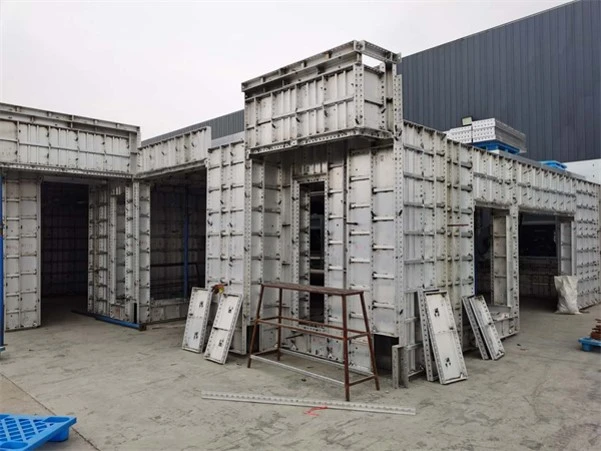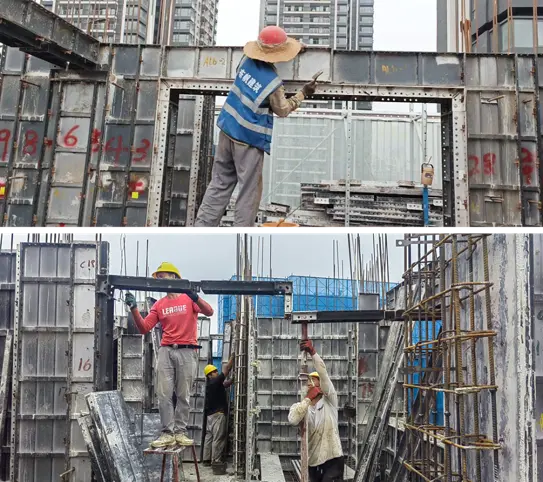aluminium formwork slab cycle

aluminium formwork , as an advanced construction material, plays a vital role in the modern construction industry. Made of high-strength aluminium alloy, it is characterized by its lightweight, corrosion resistance, thermal insulation, and durability. It is widely used in the construction of concrete structures such as walls, beams, and columns.
As a reusable formwork system, aluminium formwork not only provides a high-quality formwork surface to ensure construction accuracy and stability but also offers durability and cost-effectiveness compared to traditional wooden formwork. It demonstrates its superiority in projects with tight schedules, large-scale construction, and high-rise buildings, making it the preferred material for modern construction.
However, with the rapid development of the construction industry, a significant amount of waste from wooden formwork and steel formwork has been generated, creating immense pressure on the environment. Therefore, finding effective ways to utilize and optimize the use of formwork, reduce resource consumption, and minimize environmental pollution, has become a pressing issue that needs to be addressed urgently.
The use of aluminium formwork slab cycle not only reduces the consumption of raw materials and lowers construction costs but also effectively decreases waste emissions, aligning with the principles of sustainable development. In this article, we will delve into the aluminium formwork slab cycle process and the benefits it brings, providing insights and guidance for promoting the development of sustainable architecture.
● advantages of aluminium formwork
1. Excellent stability: Aluminium formwork weight is lighter compared to other construction formwork materials, making it easier to transport and install. Additionally, it has high strength, allowing it to withstand significant construction loads and pressures, ensuring safety and stability during the construction process.
2. Reusability: Aluminium formwork slab cycle exhibits excellent performance and, when used and maintained correctly, can be reused for up to 300 cycles, providing a longer lifespan. Compared to traditional wooden formwork, formwork for aluminium is more durable, corrosion-resistant, and less prone to deformation and damage. By promoting reusability, it reduces the demand for new materials, thus lowering resource consumption and construction costs.
3. High construction efficiency: Aluminium formwork installation and dismantling processes are fast, with a single worker able to install 30m2 in a day, significantly improving construction efficiency. Unlike traditional wooden formwork, aluminium formwork does not require additional finishing or treatment, making the installation process simple and convenient, thereby saving construction time and labor costs. It adopts a modular design with complete accessories, allowing for quick assembly and dismantling, effectively reducing construction duration.
4. Flexible design: Aluminium formwork design offers a variety of options, allowing for customization and processing according to different architectural requirements, accommodating various complex building structures.
5. Excellent surface quality: Formwork for aluminium has a smooth and even surface, ensuring a high-quality architectural finish. Compared to traditional wooden formwork, it guarantees construction accuracy and stability throughout the construction process. Additionally, Formwork for aluminium is not affected by moisture or temperature variations, eliminating issues of expansion or contraction, thus providing a more accurate and stable construction reference. These characteristics ensure that surfaces of building components such as walls, beams, and floors are uniform and refined, enhancing the overall quality and appearance of the structure.
6. Environmentally friendly: Aluminium formwork material is a recyclable and reusable material. It reduces the consumption of finite resources and mitigates the environmental impact of the construction industry, aligning with the requirements of sustainable construction.
● How to increase formwork cycle times
1. cleaning
Timely remove bulk impurities such as concrete and mortar from the surface of aluminium formwork shuttering. For particularly severe areas, aluminium formwork cleaning chemicals can be used for cleaning.
2. sorting
Divide the formwork into standard aluminium wall formwork, standard deck panel, and standard aluminium formwork beams, and count the number of each type of formworks. non-standard formworks or formworks with too large deformation should be treated as waste.
3. high-pressure washing
After cleaning, formwork for aluminium should be washed with a high-pressure water gun to ensure that the surface is free of any impurities. In particular, the concrete contact surfaces and the edges of the formwork ribs should be washed.
4. Welding
After being washed, the formwork for aluminium should be inspected for welding quality and hole positions. If there are cracks in the welds or extra holes on the plate surface, they need to be repaired by welding.
5. calibration
For used aluminium formwork that has been deformed and repaired by welding, calibration, and grinding are necessary. During this process, it is important to ensure the flatness of the formwork, there should be no obvious protrusions, bends, or twists, and there should be no obvious damage to the formwork and welds. Through these measures, we can ensure that the quality of the formwork meets the standard.
6. establishing database
After maintenance, aluminium formwork will be packaged and stacked according to classification standards, and the package number, model, and quantity will be recorded and counted in the warehouse. At the same time, these data will be entered into the database and arranged in a certain order for easy retrieval of the formwork model and quantity when needed. This process helps us better manage and utilize our formwork inventory.
● Used aluminium formwork modification
The old aluminium formwork modification requires the use of professional processing equipment and strict adherence to the following procedures:
▲ cutting
1) When cutting the raw materials, it is necessary to label the formwork number, specification size, and type at the appropriate position.
2) During production, it is important to have a clear understanding of the hole opening situation of the formwork and follow the size requirements for standard and non-standard components in the aluminium formwork checklist.
▲punching hole
1. On the hole-making equipment, the formwork is fixed before drilling holes. If a hole-making error occurs, the formwork will be repositioned and hole-making after repair welding, and grinding.
2. Due to the horizontal reinforcement ribs on the back of used aluminium formwork, we need to manually position them according to the hole positioning line and drawings. During positioning, we must be extremely accurate and control the error within 2mm.
▲ correcting
When correcting old formworks, if some parts cannot be reformed properly, we need to use wooden blocks or other items to pad them to assist correction. It is strictly prohibited to allow deformed formworks to flow into the next process or use at construction sites.
▲ welding
During welding, we need to pay attention to the flatness of the welding position, avoid problems such as incomplete welding and virtual welding, and ensure that the welding angle meets the requirements.
▲ powder coating
1. After completing the welding work of aluminium tilt panel formwork for sale, we need to carry out Powder coating treatment on it to form a uniform coating. Then, we should prepare a data list and store it in the warehouse.
Practical experience has proved that after old aluminium formwork refurbishment, the quality of concrete pouring is almost the same as that of new formwork s, and the cost is greatly reduced, which realizes the recycling of the template system.
● Benefits of aluminium formwork slab cycle:
1. Reduced aluminium formwork cost: Through the use of the aluminium formwork slab cycle, the costs associated with frequent purchase and replacement of formwork are minimized. Long-term usage allows for the amortization of its procurement cost and saves on subsequent maintenance and disposal expenses, thus reducing the overall cost of construction projects.
2. Decreased resource consumption and waste: The aluminium formwork slab cycle effectively reduces the demand for timber, thereby lowering the consumption of raw materials. Additionally, the aluminium formwork profiles can be recycled and reused, resulting in significant resource savings. This not only contributes to the reduction of waste generation and minimizes the environmental burden but also leads to cost reduction in construction and improves economic efficiency.
3. Increased construction efficiency and building quality: The aluminium formwork construction process is more efficient and convenient. It offers faster installation and dismantling speeds, eliminating the need for additional trimming and processing and reducing construction time and labor input. Furthermore, it ensures construction accuracy and quality, enhancing the structural stability and overall performance of buildings.
4. Promoting sustainable building development: The aluminium formwork slab cycle aligns with the principles and requirements of sustainable building. By reducing resource consumption, minimizing waste generation, and decreasing environmental pollution, it drives the development of sustainable construction.
The utilisation of the aluminium formwork slab cycle enables resource conservation, cost reduction, environmental emissions reduction, improved construction efficiency, and promotes sustainable development. These benefits make aluminium formwork an increasingly popular choice in the construction industry, driving the industry towards a more sustainable and environmentally friendly direction.
● Future trends of aluminium formwork:
With increasing awareness and emphasis on environmental protection and sustainable development, there is a growing demand for green and eco-friendly buildings, highlighting the significance of the aluminium formwork system. As a reusable and recyclable construction material, aluminium formwork exhibits high environmental friendliness and sustainability. Therefore, strengthening recycling and reutilization efforts to promote the reuse of more used aluminium formwork will become an important trend for future development.
In the construction industry, it is possible to establish a comprehensive aluminium formwork recycling system that implements centralized collection, sorting, and processing of used aluminium formwork to transform them into new aluminium formwork.
Therefore, the recycling of aluminium formwork is an important measure to promote the development of sustainable construction. By increasing the number of times aluminium formwork is reused and establishing a recycling system, we can promote recycling and reutilization efforts, reduce resource consumption, minimize environmental pollution, and achieve the sustainable development goals of the construction industry.
● Recommended


